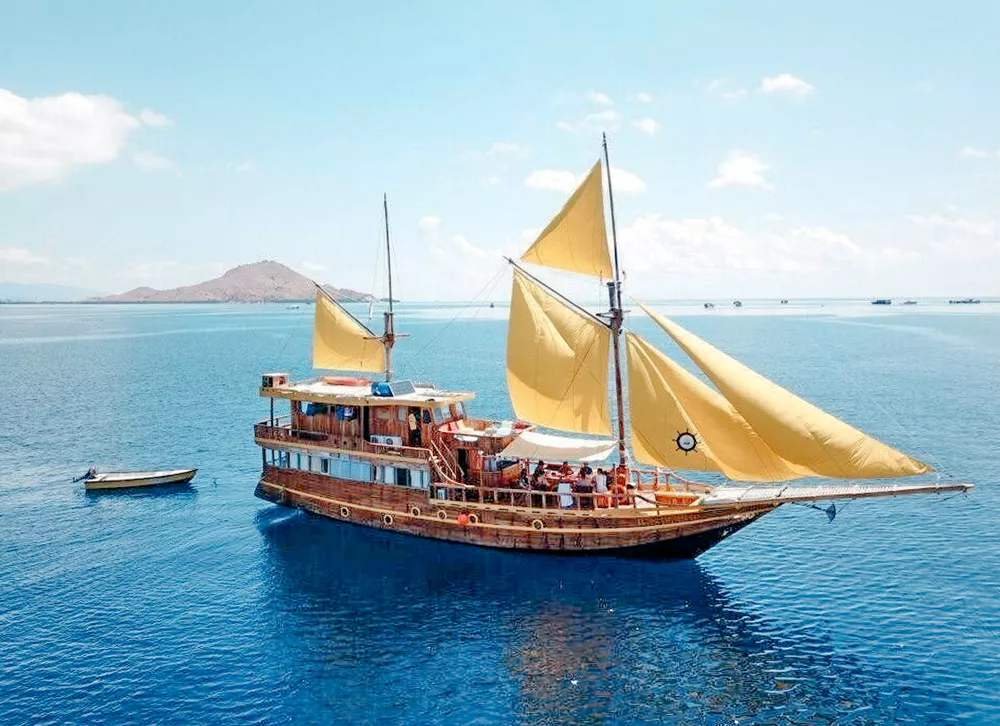The first five minutes after leaving Labuan Bajo are a kind of quiet that hums. The harbor stretches, wooden phinisi boats blink in the light, and the water decides it wants to be turquoise, then glass, then something between the two. Shoes off, sunscreen on. The deck becomes your living room and the horizon does that irresistible thing where it keeps opening.
I came for the ocean, sure, but also for the soft spaces between adventures: the slow coffee on a breezy bow, the hush before a sunrise hike, the way couples invent new shades of silence, the way kids turn a boat into a floating playground. Some call it a Komodo liveaboard, others a gentle Labuan Bajo cruise. Labels matter less when the boat slides forward and time starts behaving.
Our captain warmed us up with a ribbon of sand so delicate it looked sketched onto the sea—Taka Makassar. From onboard it was a brushstroke; up close it was a silk runway for bare feet. Masks on, and the world clicked into mosaic mode: starfish like confetti, corals rehearsing a tiny opera, fish cruising with the swagger of neighborhood regulars. No rush. Island-hopping Flores works best at the speed of curiosity.
By early afternoon the blue turned velvet, a hush that means Manta Point is near. The surface darkened as if someone dimmed the lights for a show, and then a wing appeared—broad, measured, certain. Another followed, carving the water like punctuation. We slid in as if entering a library. Snorkeling with manta rays is not about collecting video; it’s about letting your breath find the same tempo as something graceful.
Evenings belong to silhouettes. Off Kalong, mangroves held their breath until dusk, then thousands of flying foxes lifted in slow waves. Kids counted until numbers gave up; couples leaned together and forgot to speak. After dark, the crew whispered about bioluminescence. We trailed our fingers through black glass and the sea answered with tiny galaxies that bloomed and vanished like secrets keeping themselves. The deck turned into a stargazing lounge—a planetarium with better air and softer pillows.
Morning reset the script. Padar rose in copper folds, and we followed the ridge like punctuation marks heading toward an exclamation point. The climb is honest—short, steady, full of permissions to pause. At the top, three crescent bays stitched the island together, blue in three dialects. I’ve seen the photo a hundred times; in person, the air joins the view. Families traded snacks and high-fives. Honeymooners swapped cameras, then promises. Solo travelers pretended to adjust settings just to linger. Correct, all of them.
On Komodo and Rinca, the dragons asked for respect and got it. Rangers read the trails like books they love—footprints here, shade there, patience everywhere. Standing near that ancient calm feels less like danger and more like perspective: time widening, priorities lining up. The kids in our group asked sharper questions than the adults, which felt exactly right.
Pink Beach welcomed us like a blush—crushed red coral flirting with pale sand until the shore turned peach. Float long enough and the soundtrack simplifies to cutlery from the galley, the shush of friendly waves, and laughter that travels without trying. This is the soft magic of a Komodo National Park cruise: adventure when you want it, idling bliss when you don’t, all reachable without effort.
Boat life hides its luxuries in tiny rituals. Mornings taste like coffee and papaya. Afternoons are lime wedges, wet hair, and a page or two of a book you’ll never finish because the horizon keeps interrupting. Someone always finds the breeziest corner of the deck; by day two we all pretend we knew it first. A private boat charter doesn’t mean strict schedules—it means your day obeys light, tide, and appetite.
Halfway through our loop, I wanted a quick way to share the plan with friends back home. That turned into a simple phrase the crew recognized immediately—trip Komodo—and within minutes we were sketching a route that balanced Padar sunrise, a manta drift, pink-sand lounging, and one quiet cove at golden hour; the best part was how easily they read the weather and our mood and stitched both into the day.
Adventure travelers: Komodo plays fair. Trade one hike for a second snorkel if the current looks friendly. Ask the captain to time mantas between crowds or to tuck the boat into the lee of an island when the breeze gets ideas. Ocean lovers don’t need convincing—the palette is absurd: cobalt channels, neon shallows, seams of turquoise that look Photoshopped until a turtle surfaces and proves it’s real. Couples can claim the bow cushions at sunset and rename constellations after inside jokes. Families with kids will discover an ocean classroom disguised as fun: patient crew, safe ladders, morale-boosting snacks that appear exactly on cue.
We added one of those “not-famous, perfect anyway” stops—an unnamed cove that turned the sea to glass. The ladder went down like an invitation and we accepted immediately. I floated on my back and watched swallows stitch the sky with invisible thread. Someone taught the kids to tie a bowline; someone else napped so beautifully it looked like art. The captain glanced at the shade sliding down the cliffs and said, “Five more minutes,” with the confidence of someone who negotiates with the sun and usually wins.
If frameworks soothe you, here’s one that works every time: glide out of the harbor on a balcony-view morning; step onto a sandbar for the first “wow”; drift with mantas when the sea goes velvet; float at a blush-colored beach after lunch; climb something modest at golden hour; convert the deck into a stargazing lounge after dinner. Flip the order tomorrow. Komodo is a puzzle with many right answers.
Packing notes, kept light. Reef-safe sunscreen (love letter to corals). Quick-dry towel for the smug post-snorkel moment. Thin long sleeve for starry decks. Sandals that slip on and off without debate. A dry bag because sand has a PhD in finding zippers. If you like souvenirs that weigh nothing, keep a small notebook; this place hands you sentences worth saving.
We looped toward Rinca on our last full day, walking a path that braided acacia shade with bright lookouts. Back at the jetty, boys practiced cannonballs with Olympic sincerity while grandmothers pretended not to keep score. The ladder clinked like a friendly doorbell. That’s how you know a sea day was assembled correctly: your feet step back on board without thinking.
A few LSI phrases to tuck into your planning (and then release once you’re here): Komodo liveaboard, Labuan Bajo cruise, snorkeling with manta rays, island-hopping Flores, private boat charter. They’ll open the right conversations; the ocean will do the rest.
On our final night the engine went quiet and the bay laid itself out like silk. The sky rehearsed a show we didn’t deserve but got anyway. Someone pointed—shooting star—and for once everyone saw it at the same time. We didn’t try to name the feeling; islands are better at that.
Morning sent us gliding back toward Labuan Bajo—hills stacked like resting dragons, boats moving with purposeful grace, sunlight pouring generously over everything it touched. I packed slower than necessary because rushing felt impolite. The pier arrived and the town hummed a soft welcome, but somewhere in my pockets the sea had already smuggled new habits—walk slower, look longer, say yes to plans drawn by light.
Whatever kind of traveler you are—adventure-curious, ocean-obsessed, honeymoon slow-dancers, or parents building bright memories for small explorers—Komodo meets you where you are and nudges you a little further toward wonder. The boat becomes home, the crew your easy co-authors, and the days prove that good timing and kind water can make time stretch just enough to fit everything you didn’t know you needed.

